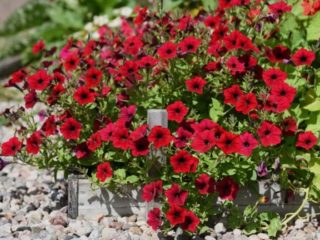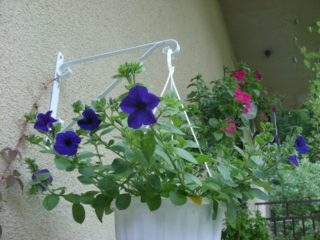Content
Petunia has long been a popular garden crop. These are elegant and colorful flowers with a pleasant aroma. The difference between petunia and surfinia is that the latter plant is classified in the varietal group of the former. Despite such a close relationship, the plants still have some differences both in appearance and in care.

Surfinia has similar cultivation and care techniques
Surfinia and petunia - what is the difference
Petunia is a member of the nightshade family, a genus of perennial herbaceous plants.
According to the type, size of bushes and shape, there are 3 types:
- Bushy or upright. The shoots stretch from 15 to 80 cm.
- Ampelous or creeping. Characterized by long shoots.
- Cascade. They have strong stems up to 2 m long.
The last two types are usually combined into one group. They don't have many differences. In an ampelous variety, the shoots fall down and do not deviate to the sides during growth. In cascading ones, young shoots initially stretch upward and then begin to spread horizontally. Their flowers are more uniform in color, while ampel flowers may have buds of different shades on the bush.
The difference between petunia and surfinia may not be noticed at first. But still, the latter species is distinguished by long and strong shoots.
Surfinia is the brainchild of Japanese breeders. In fact, it is a varietal group of ampelous petunias.The growth of shoots is rapid. They droop if grown in hanging pots. Formed from internodes. They can reach 2 meters in length, unlike their “parent”, which rarely stretches more than 1.5 meters. It has many varieties. The most popular include:
- «Burgundy"(Burgundy), with large flowers up to 8 cm in diameter, which have a wine tint.
- «Table White» (Table White) - with white flowers that look like bells.
- «Red"(Red). Characterized by a pure scarlet hue of flowers. The variety has received awards at exhibitions many times.
There are a number of characteristics that distinguish surfinia from ampelous petunia:
- hanging plants have thin shoots, while the variety has branching and powerful shoots;
- Surfinia is propagated by cuttings, and ampelous varieties are propagated mainly by seeds;
- The variety is considered more hardy; it quickly recovers from severe weather conditions, while other varieties do not tolerate wind well, and the leaves become deformed from rain.

Both types of plants are propagated by cuttings
Differences in planting and care
As you can see in the photo, the difference between surfinia and petunia is insignificant, moreover, the first type is a hybrid of the second, so there are no special differences in care.
Both species prefer nutritious soil, which should be loosened periodically.
At the same time, petunia feels equally good in flower beds and in pots. Surfinia is planted exclusively in closed loamy soil and watered frequently. “Parent” prefers sandy loam soils, without special requirements for watering frequency.
Both plants love warmth and sunlight, and in partial shade the number of flowers is greatly reduced. Therefore, it is very important that the plant develops in a sunny place.
Before you take the surfinia outside, you will have to prepare it, that is, take pots of flowers out into the open air for several days, for several hours, gradually increasing the amount of time you spend on it there. Petunia is undemanding in this matter; she does not need special training. The bushes are immediately taken out in pots or planted in flower beds.
Surfinia can also be propagated by seed, but experienced gardeners never resort to this technique. The fact is that a bush always produces few seeds. And if you buy them, there is a huge risk that the bag of seeds will contain 50-60% sand.
You shouldn’t count on a lush bush grown from seeds. Such plants are characterized by short stature and sparse flowering. Therefore, the best method of propagation is cuttings.

Petunia grows well in open ground
Which is better - petunia or surfinia
There is no clear answer to this question. Both types allow you to decorate your garden plot and have excellent decorative properties. Plants do not require special care conditions.
The main difference between surfinia and petunia is that it can be grown exclusively indoors. For many this is an advantage; the flower can be placed in a gazebo or on a terrace, ideal for vertical gardening.
Surfinia will overwinter well even in the basement; it will not produce leaves or flowers. But as soon as it becomes warm and the spring rays of the sun are directed at it, it immediately awakens and releases foliage. Petunia can even overwinter in a flowerbed.
Classic representatives of petunias are cheaper, unlike the varietal variety. But both plants can be propagated by cuttings.

One petunia bush can have flowers of different colors.
Conclusion
The differences between petunia and surfinia are small, but they should still be taken into account during cultivation. Both species bloom more magnificently and beautifully every year. And surfinia, unlike petunia, always has a rich and pure color of flowers. In the latter type, flowers of different colors may be observed on one bush, which is not typical for the first variety.







